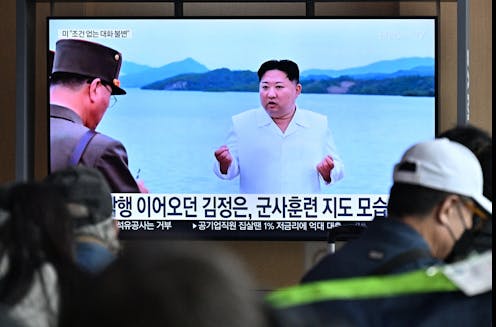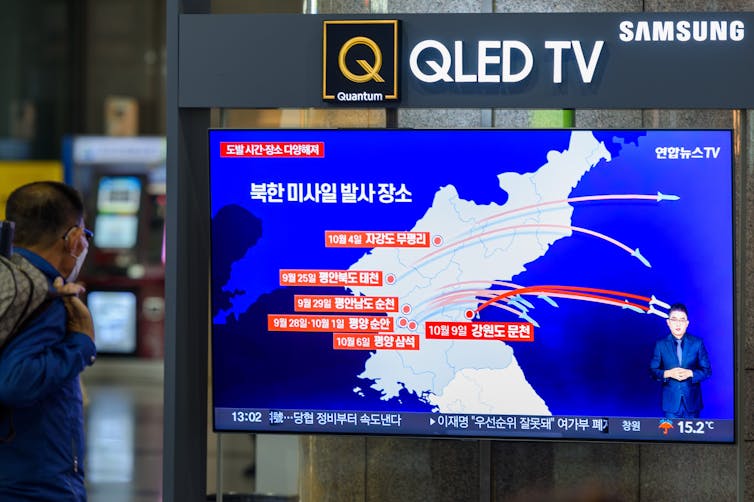It's time to take Kim Jong Un and his nuclear threats seriously
A recent barrage of nuclear-capable missile tests and a change in law setting out the conditions for a nuclear strike show that North Korea’s leader is intent on reunification on his terms.

As the West frets over the possibility of Vladimir Putin turning to nuclear weapons in Ukraine, there is a risk that similar threats posed by another pariah leader are not being treated as seriously – those of North Korea’s Kim Jong Un.
The isolationist East Asian nation has conducted seven nuclear-capable missile blasts over the course of 15 days, from Sept. 25 to Oct. 9, 2022. One flew over Japan, plunging into the Pacific after flying 2,800 miles – a distance that puts the U.S. military base in Guam within range.
Then, on Oct. 10 – the 77th anniversary of the founding of North Korea’s communist Workers Party – state media announced that Kim had personally conducted field guidance of his nation’s “tactical nuclear operation units,” which displayed the capacity to “hit and wipe out” enemy targets.
True, Russia’s enormous nuclear arsenal make its threats more credible than North Korea’s. Moscow has the means, and fear over defeat in Ukraine could provide the motive.
There is another reason that Kim’s nuclear threats may sound less ominous, if not entirely hollow. North Korea’s leader strikes many in the West almost as a laughable figure – a narcissistic, well-nourished dictator with, to many, a comical look. Yes, he harbors worrying nuclear bomb ambitions and presides over a desperate state facing widespread hunger. But his occasional threats to nuke his southern neighbor – South Korea – are greeted by many as little more than buffoonish bellicosity. Take, for example, then-President Donald Trump’s 2017 speech at the United Nations in which he belittled Kim as a “Rocket Man on a suicide mission.”
But as a scholar of Korean history who has watched as the North’s regime has threatened to destabilize the region, I believe Kim must be taken seriously. He is deadly serious about completing his grandfather’s and father’s mission of reunification of the Korean peninsula. It is the dynasty’s “supreme national task,” and there is little to suggest that Kim won’t resort to any length to make that happen.
Preemptive nuclear strikes
In 2022 alone, North Korea has fired over 30 missiles, including six intercontinental ballistic projectiles. These activities are in “open breach of United Nations sanctions,” as the U.N. Panel of Experts on North Korea reported in September.
Yet, there has not been a single new United Nations Security Council Resolution passed in response to these serial violations. And I doubt one will be forthcoming even in the wake of a major nuclear test, which is looming. Security Council members Russia and China, which supported previous U.N. sanctions following North Korean missiles and nuclear tests, are unlikely to do so again this time amid the growing geopolitical rift with the West. Both countries actively blocked such moves led by the U.S. earlier in the year.
Worse, recent remarks by Putin and Kim have brought back the once unthinkable notion of a nation preemptively nuking a neighboring state.
In September, North Korea promulgated a new “law on the state policy on the nuclear forces.” It sets out the conditions under which North Korea would use nuclear weapons. In broad and vague terms, the law cites “taking an upper hand in a war” and being “inevitably compelled and cannot help but use nuclear weapons” as reasons to resort to the ultimate weapon.

In outlining a fairly open-ended approach to nuclear action, Kim has escalated the rhetoric and attempted to normalize the right to strike first. It lays the groundwork for using any “hostile” move by South Korea – which the regime defines broadly as anything between criticism of its human rights violations to combined defensive military exercises with the United States – as as a pretext for preemptive nuclear strikes.
Kim appears to be arguing that it is his right to use nuclear weapons whenever he deems it necessary. It is a truly frightening prospect.
A cycle of escalation
The recent nuclear-capable missile launches, coming just weeks after a new nuclear doctrine and coinciding with Putin’s escalation in Ukraine, looks to paint the U.S. into a corner and seize on the growing Cold War split. Kim is forging new norms in the politics of the region.
It may be hard to accept that North Korea – a small economic actor compared with the U.S., China, Russia, Japan and South Korea – has outmaneuvered its bigger interlocutors. But, over the past 30 years of nuclear diplomacy, it has been North Korea that has mostly called the shots – from proposing talks, agenda-setting and agenda-shifting to deciding when to walk away.
In the process, Pyongyang has wrested away billions of U.S. dollars’ worth of cash, food, fuel and other goods from other countries while building approximately 50 nuclear bombs, ICBMs and other strategic weapons.
From the Bill Clinton and George W. Bush administrations alone, North Korea received over US$1.3 billion worth in aid in return for repeated false pledges of denuclearization.
North Korea’s strategy throughout has been one that combines calculated provocations, graduated escalation and a post-provocation peace ploy. But the end game for Kim, like his father and grandfather before him, remains the same: triumphing over South Korea and incorporating its people and territory under the North’s jurisdiction.
To enable this, North Korea will need to repeat its cycles of provocations and deescalation while continuing to grow its military arsenal to the extent that it becomes a clear and present nuclear threat to the U.S. mainland and an unbearable regional liability. At that point, so the strategy goes, it can push the U.S. to withdraw forces in South Korea, rendering the South vulnerable to submission to the North’s plans.
Kim’s grand strategy
Reunification under the North’s terms is central to Kim’s plan. As such, international observers might be wise to focus more on the purpose of Kim’s provocations, rather than the cause.
Pondering “What caused Kim to test a nuke?” may lead some into the same trap as asking, “What caused Putin to invade Ukraine?”
Both questions assume the aggressor to be reactive rather than proactive and ignore his grandiose intentions.
Kim Jong Un has a grand strategy. As long as South Korea exists as a richer and more democratically legitimate Korean state that serves as a magnet for his own people, the specter of the German model of reunification – under which the richer Germany absorbed the poorer one – hovers ominously for Kim. And that, he cannot allow.
As such, world leaders must beware: When narcissistic tyrants make nuclear threats, they carry menacing meaning – even when uttered by unusually odd-looking despots.
Sung-Yoon Lee does not work for, consult, own shares in or receive funding from any company or organization that would benefit from this article, and has disclosed no relevant affiliations beyond their academic appointment.
Read These Next
With wolves absent from most of eastern North America, can coyotes replace them?
Wolves and coyotes feed on similar things – but their diets aren’t identical. A researcher studied…
There’s little evidence tech is much help stopping school shootings
The $4 billion school security industry can’t back up claims for its tech. The silver lining: That’s…
Where the wild things thrive: Finding and protecting nature’s climate change safe havens
Protecting places that are likely to remain cool and moist as global temperatures rise can save wildlife…





